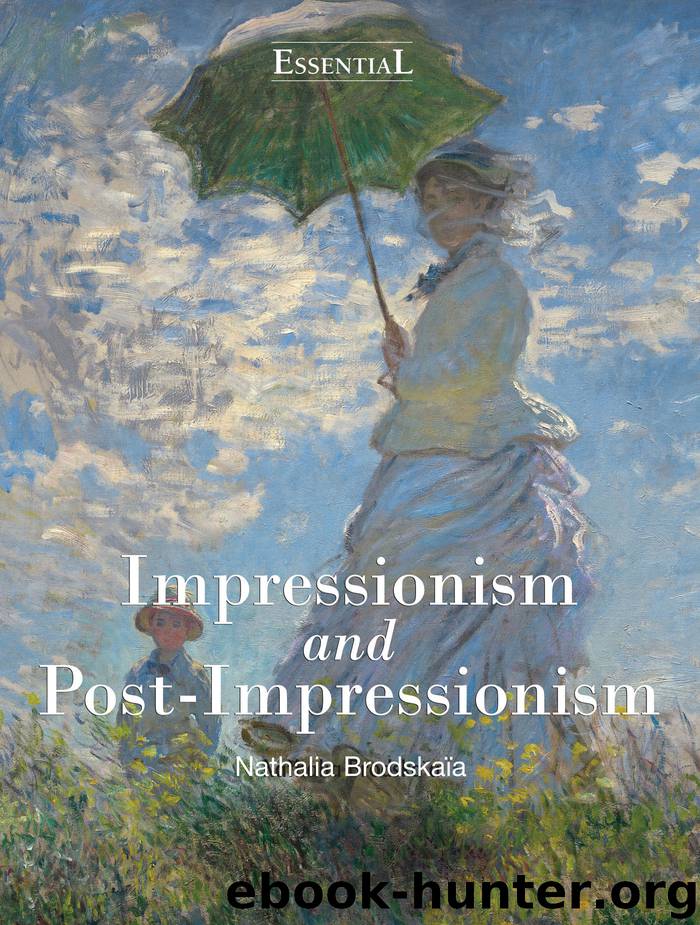Impressionism and Post-Impressionism (Essential) by Brodskaïa Nathalia

Author:Brodskaïa, Nathalia
Language: eng
Format: epub
Publisher: Parkstone International
Published: 2018-04-10T16:00:00+00:00
Berthe Morisot, At the Ball, 1875. Oil on canvas, 62 x 52 cm. Musée Marmottan, Paris.
Berthe Morisot, Reading, 1873. Oil on canvas, 46 x 71.8 cm. The Cleveland Museum of Art, Cleveland.
Berthe’s letters show at what point Manet’s opinion became important to her. She was unable to remain indifferent to his lack of attention, especially when Eva Gonzalès, the daughter of a prominent Parisian writer and student of the society painter Chaplin, appeared in Manet’s studio. Eva wanted to take lessons from Manet, who seemed to like her very much and this preference was painful for Berthe. In August she wrote to her sister: “Manet gave me a lecture and offered the eternal Miss Gonzalès as a model; she has good manners and determination, she knows how to bring something to a successful conclusion, whereas I am incapable of anything. Meanwhile, he restarted his portrait for the twenty-fifth time.” (Correspondance de Berthe Morisot, op. cit., p. 33). Manet also preferred Eva as a model for his painting. “We spent last Thursday evening together at Manet’s, who was wildly happy,” she wrote in September. “For a quarter hour, all his attention was concentrated on Miss Gonzalès, but her portrait still shows no progress.” (Correspondance de Berthe Morisot, op. cit., p. 35). Berthe’s landscapes painted in Lorient had impressed a painter as respectable as Puvis de Chavannes, but Manet’s opinion mattered more to her. “The Manets came to see us Tuesday night and we went into the studio; to my great surprise and happiness I received the greatest praises,” she wrote with satisfaction. “It appears that it’s definitively better than Eva Gonzalès. Manet is too frank for one to get the wrong impression, I am sure that it pleased him a lot; but I remember what Fantin-Latour said: ‘He always thinks the painting of people he likes is good’.” (Correspondance de Berthe Morisot, op. cit., p. 35). Berthe would become even more upset, because in her opinion, the portrait of Eva Gonzalès, once finished, was exemplary. “Manet has never done anything as good as the portrait of Miss Gonzalès; it may have even more charm than when you saw it,” she wrote to her sister.
Berthe was always prone to self-doubt and torment. After having praised the canvases that she did in Lorient, Manet added that it was unlikely they would be accepted in the Salon of 1869. The days leading up to the opening were torture for her. Finally the Salon opened and she saw her painting had been included. “The exhibition revived Berthe some,” Mrs Morisot wrote to Edma. “Berthe received quite a few complements on her exhibit; she had her ups and downs like before; all the same, she was definitely a little distracted this week; I worry that this is only going to throw her into an even greater depression,” Mrs Morisot wrote anxiously. The late 1860s and the early 1870s was an especially painful period for Berthe. Her two sisters were married; only Berthe, now thirty, still lived with her parents, although she was much courted.
Download
This site does not store any files on its server. We only index and link to content provided by other sites. Please contact the content providers to delete copyright contents if any and email us, we'll remove relevant links or contents immediately.
The Secret History by Donna Tartt(18168)
Red Sparrow by Jason Matthews(5199)
Harry Potter 02 & The Chamber Of Secrets (Illustrated) by J.K. Rowling(3556)
In a Sunburned Country by Bill Bryson(3371)
Drawing Cutting Edge Anatomy by Christopher Hart(3291)
Figure Drawing for Artists by Steve Huston(3274)
Harry Potter and the Prisoner of Azkaban (Book 3) by J. K. Rowling(3113)
The Daily Stoic by Holiday Ryan & Hanselman Stephen(3111)
Japanese Design by Patricia J. Graham(3003)
The Roots of Romanticism (Second Edition) by Berlin Isaiah Hardy Henry Gray John(2822)
Make Comics Like the Pros by Greg Pak(2760)
Stacked Decks by The Rotenberg Collection(2690)
Harry Potter and the Deathly Hallows (7) by J.K. Rowling(2552)
Draw-A-Saurus by James Silvani(2506)
Tattoo Art by Doralba Picerno(2491)
On Photography by Susan Sontag(2488)
Foreign Devils on the Silk Road: The Search for the Lost Treasures of Central Asia by Peter Hopkirk(2389)
Churchill by Paul Johnson(2368)
The Daily Stoic by Ryan Holiday & Stephen Hanselman(2346)
